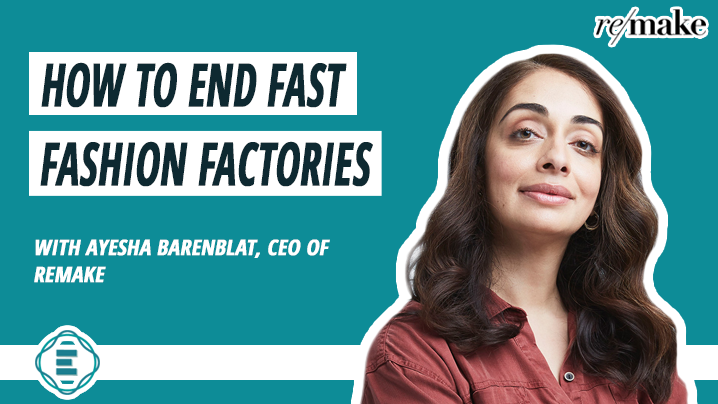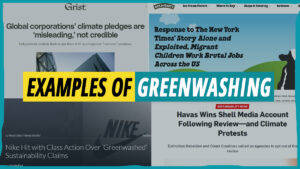Part of our ongoing Impact of Fashion series with our partner, Dhana

Fast fashion brands lead us to believe it’s as easy as buy, buy, buy. There’s no time to wonder about the humans behind T-shirt production because we’ve found a good deal.
Now, as we learn more about the human cost of garment production, we know fast fashion cannot continue. Garment workers are facing food insecurity, poverty, and unsafe working conditions. Changemakers everywhere have the power to work collectively and spark lasting change.
Sure, regulating labor rights and protecting garment workers won’t be easy. But Ayesha Barenblat, founder and CEO of Remake, shows us we can all play a part in advocating for garment workers. In a conversation with Cory on the Social Entrepreneurship and Innovation Podcast, Ayesha explains why workers’ rights are central to the future of fashion.
Fast fashion can’t continue distancing itself from the people behind the products. In this post, we’ll dive deeper into factory working conditions and provide a roadmap for protecting garment workers and advocating for a better future together.
What are the Conditions Like in Fast Fashion Factories?
“It’s just unconscionable that here we are, in the 21st century, with a take-home pay of $2 to $5.” – Ayesha Barenblat
We often assume terrible working conditions are far away, in developing countries, but Los Angeles has the highest concentration of fashion factory workers in the country. And until the Garment Worker Protection Act was signed in September 2021, garment workers in California weren’t ensured fair wages.
Still, garment workers in other states and countries face poor treatment without protection from the law.
For more on how fast fashion came to be, consider reading: The History of Fast Fashion.
How Much do Garment Workers Get Paid?
“For a multi-trillion-dollar industry, it doesn’t have to be this way.” – Ayesha Barenblat
Paid by the Piece
Fast fashion workers aren’t guaranteed a minimum or hourly wage. Instead, they’re usually paid by the piece—sometimes earning as low as $.03 per blouse they’ve trimmed or label they’ve stitched, coming nowhere close to reaching minimum wage.
Food Insecurity
With earnings below the living wage, many garment workers struggle to make ends meet and are unable to put food on the table for their families. In April 2020, only 3% of garment workers were eating enough food. Facing food insecurity means garment workers aren’t adequately nourished and are living in poverty, even when they work over 70 hours a week.
How Many Hours do Garment Workers Work Per Day?
In general, fast fashion laborers work about 8–12 hours per day. In Los Angeles, they work about 10–12.
One worker in LA said her job is to stitch tags, such as “Made in America” or “Made in LA” labels, which pay around 3 cents per piece. To bring home $300, she needs to work 60–75 hours a week (or 12–15 hours a day).
That means she’s taking home around $4–$5 an hour.
With a living wage of $19.35 and a minimum wage of $12 in LA County, garment workers are severely underpaid and unable to cover basic necessities.
Do Garment Workers Get Breaks?
Garment workers are incentivized to work without breaks. Taking a break means taking time away from creating another piece, which means a reduction in their take-home pay.
What are the Health Impacts of Fast Fashion Factories?
An estimated 85% of garment workers are women, which gives rise to a host of health issues for those working in fast fashion factories.
1. Mental health
The high-pressure working conditions in factories can have a profound impact on buy watson brand soma online mental and physical health. Stress and anxiety from working in factories have been found to contribute to hypertensive disorders of pregnancy; a leading cause of maternal death.
2. Respiratory issues
In some factories, garment workers inhale potentially toxic fumes for hours on end. With poor ventilation in factories, cotton dust and synthetic air particles lead to poor respiratory health.
3. Musculoskeletal hazards
Garment workers often experience musculoskeletal effects from repetitive and motion-intensive tasks.
Other health impacts include “debilitating and life-threatening conditions such as lung disease and cancer.”
4. Poor Sanitation and Unsafe Conditions
With unsanitary and unsafe working conditions, garment workers’ lives are at risk. In a survey by the UCLA Labor Center over 300 garment workers shared complaints about “unsanitary bathroom conditions, blocked doors and exits and excessive dust, heat and poor ventilation.”
Ensuring garment worker health and safety is crucial to creating a sustainable and ethical fashion industry.
Why is Fast Fashion Labor Hard to Regulate?
“Most of our fashion is made by large multinational conglomerates who have no interest or connection to any of the communities where their product is made.” – Ayesha Barenblat
The fashion industry depends on farmers, factories, and garment workers across the globe. Out of the 31 fashion industry executives surveyed, 36.7% said they source from more than 10 countries or regions.
Fast fashion is difficult to regulate for three major reasons:
1. Web of Suppliers
With cotton being produced in 80 different countries and less than 3% of clothing made in the US, fast fashion brands lean on outsourcing to produce our clothing.
“What brands have managed to do is essentially outsource all risk,” Ayesha said. “You’ve got a regulatory gap, you’ve got the way the garment industry operates, which is just pushing all of the delivery path pressure, cost pressure onto manufacturers, and then you have an asymmetry of power.”
Adding another tangled thread are subcontractors. Companies often rely on agents to select factories and manufacturers, further separating themselves from fast fashion garment workers.
2. Competitive Landscape
In a survey by the International Labour Organization, 52 percent of apparel suppliers said brands paid prices lower than production costs. More than half of the respondents are taking on orders they can’t afford to produce.
Fast fashion creates a race to the bottom—finding the quickest turnarounds and the lowest pricing.
When Ayesha asked factory owners how they can afford to produce a pair of pants at such a low price point, they say, “If we don’t take it, then the brand will just take it to the guy next door.”
Factory owners and manufacturers need to bring in more business to stay afloat, even if it’s at the cost of providing a living wage. They’re in a race to the bottom.
One supplier shared that he sometimes needs to confirm a lead time without any security or buffer from the brand. “If we don’t agree to the lead times, we might lose the order,” he said.
3. Hidden Commercial Practices
“Because brands’ commercial practices are so hidden, it’s very hard to hold them accountable.” – Ayesha Barenblat
With hidden commercial practices, it’s difficult to know the full story of fast fashion labor. How are garment workers treated in Bangladesh? How well are workers compensated in Vietnam?
Aruna Kashyap, senior counsel in the women’s rights division at Human Rights Watch, attributes garment worker abuse to poor sourcing and purchasing practices in the garment industry.
“Suppliers face powerful incentives to cut costs in ways that exacerbate workplace abuses and heighten brands’ exposure to human rights risks,” Aruna said. “Many brands demand their suppliers maintain rights-respecting workplaces, but then incentivize them to do the opposite.”
Ayesha explained it this way: the reason we have cheap clothes is because of the prices brands pay. “Whether you’re working in a sweatshop in Karachi, or in Phnom Penh, or in LA, it ultimately comes down to the commercial practices of the brands,” she said.
How Should the Fashion Industry Treat Workers?
“If we’re to build back better from this pandemic, what does ‘good’ really look like?” – Ayesha Barenblat
In March 2020, key players in the fashion industry made a catastrophic decision to cancel their orders and refuse payment.
An estimated $40 billion goods sat completely finished with nowhere to go. And millions of garment workers were left unpaid.
The Pay Up Campaign was formed to create a global coalition and demand payment to protect millions of garment workers and their families from going hungry.
Here are four key standards to ensure fair treatment of garment industry workers, according to Ayesha:
1. Keep Workers Safe.
As of May 2021, in Bangladesh alone, 1,242 factories haven’t installed fire alarms and 377 haven’t addressed structural building flaws.
At a bare minimum, keeping garment workers safe means ensuring structurally sound buildings, training on fire safety processes, and having clear and accessible fire exits. A crucial step to protecting the lives of garment workers is ensuring safe working environments.
2. Provide Living Wages.
Fashion factories are employed by people who cannot meet their basic needs, with less than 2% of garment workers earning a living wage. PayUp calls for brands to end starvation wages so garment workers can provide for themselves and their families.
3. Use Enforceable, Legally Binding Contracts.
Brands and retailers must be held accountable, instead of putting liability on other subcontractors and suppliers. Creating legally binding contract agreements will address the “power imbalance in fashion that pushes financial risk onto suppliers and thus human rights and labor rights abuses onto workers.”
One example is the Accord on Fire and Building Safety in Bangladesh, a legally binding agreement requiring independent safety inspections and corrective action. Between 2013 and 2018, inspectors found over 122,000 safety violations and by October 2018, 90% of the violations had been fixed.
Include Garment Workers at the Table.
One thing Ayesha noticed in her advocacy work is the number of companies that do not include garment workers’ voices in the conversation about sustainability and ethical treatment. “So many sustainable fashion panels and conversations have no voices from the global south, no voices from producing countries, no people close to the pain of the pandemic and brands’ purchasing practices,” she said.
“For too long, these multi-stakeholder initiatives, brand paid for and brand-led, have controlled the conversation and we have seen very little progress.”
Having a voice at the table could start with having garment workers be a part of the discussion at fashion summits and conferences. Another way to elevate voices is through worker unions, to help with negotiations between brands and factories, and advocate for garment workers.
The Roadmap to Garment Worker Protection
“How long are people going to essentially have to lose their lives and dignity in our quest for cheap clothes?” – Ayesha Barenblat
For Consumers: Advocacy
If there’s anything the Garment Worker Protection Act in California can teach us, it’s that advocacy is a powerful tool for creating change together.
But don’t worry, advocacy doesn’t necessarily mean door-knocking or cold calling (though those are excellent ways to get involved too!). Remake is on a mission to make advocacy easy. Here are four ways you can advocate for garment workers today:
- Sign the #PayUp Petition: Show your support for brands compensating the millions of garment workers who were laid off globally without pay due to brand order cancellations.
- Spread the word: Share some of the latest news from Remake on your social media. Host a film screening to spread awareness in your community.
- Donate: Give to the Garment Workers Relief fund.
- Get active: Become an ambassador with Remake. Or try volunteering for your country’s Fashion Revolution team.
No matter how you decide to get involved, remember, small steps make a real difference.
For Brands: Transparency
“It’s really hard as an everyday customer to know who are the better brands. Who are the brands that are causing a lot of environmental damage and human rights abuse?” Ayesha said.
There needs to be a push for transparency from brands and a push for educating consumers. Ayesha said, “We’re here to really disrupt the conversation to educate everyday people to ask the right questions of brands,”
In the podcast, Ayesha shared some important questions to ask brands, including:
- Why are there children in factories?
- Why are the working conditions so unsafe?
- Why do workers work around the clock in structurally unsafe buildings?
- Why are women robbed of their wages?
Knowing the right questions to ask will help consumers find the brands they want to support.
Fortunately, some brands have started to publish their supplier list to open communication and build consumer trust. But this is just the first step towards true transparency. To dig deeper, brands will need to share more—sharing where raw materials are sourced, how farmers and factory workers are treated, how far each product travels along the supply chain, and their carbon footprint.
The more open and honest, the better. Even if it means admitting where you’ve gone wrong, or areas where you want to improve.
Brand Transparency Directory
If you’re wondering where some of your favorite clothing companies fall on the spectrum of sustainable, ethical, and transparent practices, look no further than Remake’s Brand Directory.
The brand directory is based on Remake’s transparency report, a deep study across several categories for each brand, including:
- Accessibility of information (e.g., where factories are located)
- Labor rights (e.g., are laborers paid a fair wage?)
- Environment (e.g., water, carbon, raw material usage, packaging, animal rights)

“If a brand does not disclose their policies, process, and progress publicly, we give them zero points because we know that transparency is the first step towards turning fashion into a force for good,” Ayesha said.
For Governments: Policymaking
“Our earth and people can’t sustain this race to the bottom that we’ve been engaged in over the last decade.” – Ayesha Barenblat
Protecting garment workers can’t rest on brands and consumers alone. We need to approach garment worker rights from all fronts. We need local, statewide, and national policies to protect garment workers through government regulation.
“We certainly need smart regulation, like the Garment Worker Protection Act,” Ayesha said, “Not just here in California, but in New York, where we also still have manufacturing. We are thinking about this at a federal level.”
Here are the three key ways legislation can help protect garment workers:
- Expanding liability and accountability: legislation must ensure brands can’t use layers of contractors or webs of suppliers to avoid liability.
- Prohibiting “pay-per-piece”: banning this common payment practice will help protect the health of workers and remove the barrier to earning a minimum wage.
- Protecting from wage theft: legislation needs to “explicitly authorize the Labor Commissioner’s Bureau of Field Enforcement (BOFE) to investigate and cite guarantors for wage theft.”
The Garment Worker Protection Act in California is a great example of the power of citizens and governments working together. “This bill is a landmark in terms of being worker-led legislation, with us coming together as a citizen and business coalition to do what’s right,” Ayesha said.
Remake: Turning Fashion into a Force for Good
Ayesha Barenblat, Founder & CEO of Remake

“I had enough of trying to make change on the inside and wanting to do something more disruptive from the outside.”
Ayesha Barenblat is a social entrepreneur with 15 years in the social justice and sustainability space. She was working in public policy for the UN’s International Labour Organization around the time of the Rana Plaza Disaster. As she learned more about fast fashion and garment worker rights, she decided to focus her career on promoting the rights and dignity of the women who make our clothes.
She founded Remake, an organization dedicated to education, transparency, and advocacy in the fashion industry. Remake educates consumers on how human rights and the climate crises are connected to fashion and aims to make the industry more just and accountable. By pushing for smart regulation and building coalitions around the labor movement, she hopes to make fashion a force for good.
“It’s been very freeing to be on this advocacy journey. I’m fueled every day by the young changemakers, our ambassador community, in universities across the United States, as well as fashion professionals that are a part of the network.” — Ayesha Barenblat
Tips for Conscious Consumers and Changemakers: 4 Ways to Start a Cultural Transformation and Help Garment Workers
“The ultimate goal is to make fashion a force for good.” – Ayesha Barenblat
1. Be Kind to Yourself.
With terrible headlines pelting us like hail on the daily, you almost want to put your sheet over your head and say, “I can’t do anything.”
Ayesha told Cory she can feel that way too. “We live in this clickbait culture,” she said. “I always love to tell our Changemaker community to not get overwhelmed.”
Ayesha encourages you to remind yourself that little steps do add up to transformative change. Be kind to yourself and keep the course.
2. Start with Your Wardrobe.
One “Made in the US” label isn’t a stamp of approval for ethical treatment, unfortunately. But this isn’t a time to feel regretful or guilty; it’s a time for reflection to make smart choices moving forward.
Reflect on your buying habits. Do you know what’s in your closet? Before you make a purchase, consider whether you need to buy a new item at all. Can you swap with a friend?
If you do decide you need to add something new to your closet, opt for ethical brands that provide Fair Trade and GOTs certified products.
3. Use Your Voice.
Think of each conversation about garment workers as a seed planted for a better, brighter future. While it’s tempting to avoid hot topics at the dinner table, sharing your knowledge is crucial to transforming our culture.
Share what you learn so your friends and family can make intentional buying decisions. Then, they will in turn spread this knowledge to their circles. Use your social media to share articles, podcasts, and research along the way. We can all play a role in making lasting change.
4. Be an Advocate.
“So much of this is about getting involved locally, statewide, nationally, in the policy-making process. This is the way to make change.” – Ayesha Barenblat
Engaging in the political process can be as easy as making a phone call or sending an email. “It’s a couple of minutes of your time with a profound way of making a difference,” said Ayesha.
Taking action doesn’t have to be saved for Election Day either. Remake makes it simple by providing scripts, phone numbers, and email addresses for people to make their voices heard.
Closing: Transformation Takes Collective Action
Individual consumers have so much more than buying power: we have our voices. While choosing to buy fair trade and ethical products is a great step on the sustainable fashion journey, it’s not the end of the road. Buying power only takes us so far.
Sparking a cultural transformation takes collective action and smart policymaking. With our wallets and our voices, change is possible together.
Additional Resources and Links Mentioned from the Episode:
- Remake on Instagram
- Remake.world
- Remake’s Brand Directory
- Overdressed by Elizabeth Cline
- Garment Worker Protection Act
- The Payup Campaign
- The Accord on Fire and Building Safety
- The Rana Plaza Disaster
- The Garment Worker Center
- Awaj Foundation

Karonica Paige
Grow Ensemble Contributor
Karonica is a content writer focused on helping purpose-driven and sustainable businesses connect with more people. Using her background in college admissions and customer service, she writes and edits to serve others with kind, clear, and educational content.
Karonica has written blogs and scripts for everyone from food startups to nonprofits, to SAAS and e-commerce companies. She’s an aspiring green thumb who loves reading, hiking, and making fresh salsa every week.






Leave a Reply